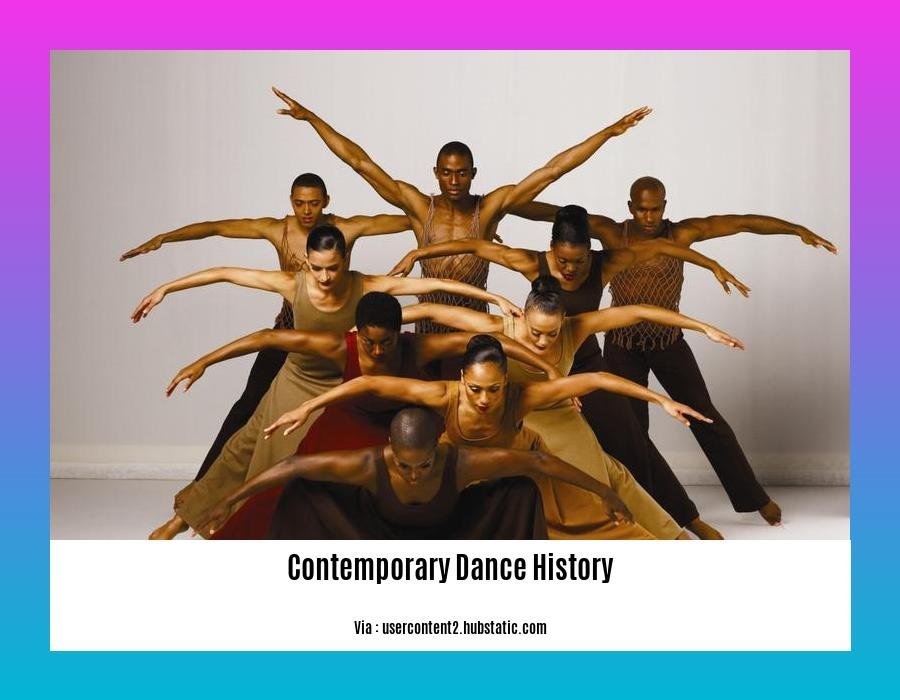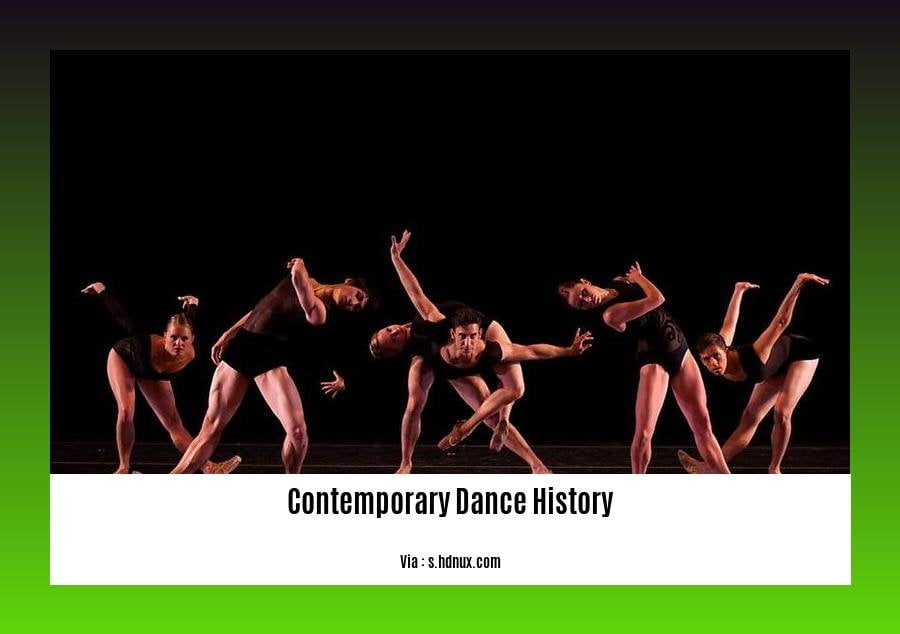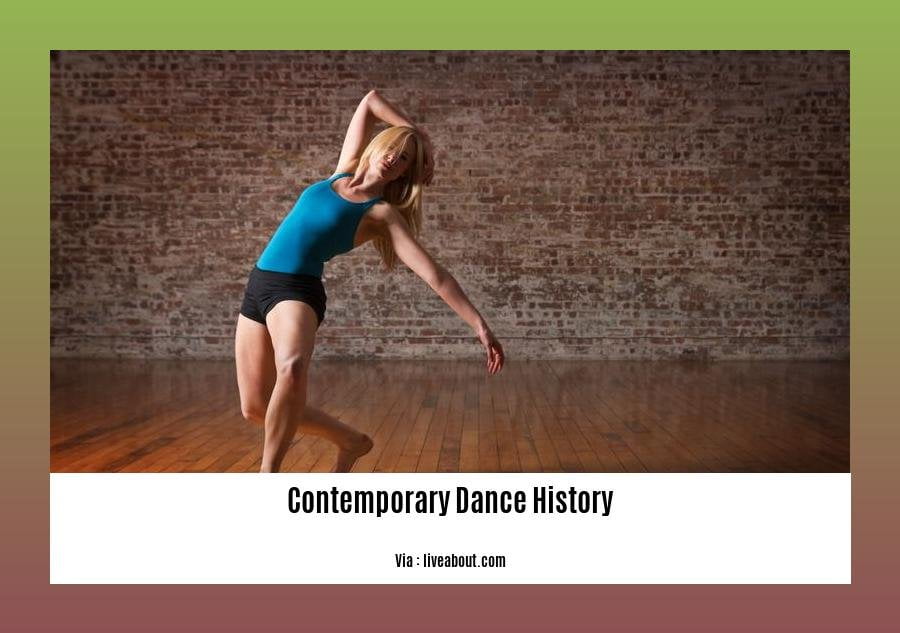Embark on an extraordinary odyssey through the captivating world of contemporary dance history. Delve into the rich tapestry of this ever-evolving art form, from its humble origins to its current status as a global phenomenon. [[Phrase Match] Embracing Evolution: A Journey Through Contemporary Dance History] promises an immersive exploration of groundbreaking performances, influential choreographers, and the profound impact of this genre on society. Brace yourself for a journey that will challenge your perceptions, ignite your passions, and leave you with a newfound appreciation for the transformative power of dance.
Key Takeaways:
Contemporary dance emerged in the 20th century influenced by modern, postmodern, and contemporary pioneers.
Martha Graham revolutionized modern dance, focusing on emotional expression and body awareness, while Merce Cunningham challenged conventions, experimenting with chance and indeterminacy.
Contemporary dance combines elements of classical ballet and modern, emphasizing personal expression and creativity, often through improvisation and unconventional movements.
It incorporates elements from other art forms like music, theater, and visual arts.
Contemporary dance has become a dominant force, influencing various genres and styles, with notable companies like Alvin Ailey American Dance Theater, Martha Graham Dance Company, and Merce Cunningham Dance Company.
Contemporary Dance History

In the realm of dance, the 20th century witnessed a revolutionary shift towards contemporary dance, a genre that challenged traditional boundaries and propelled the art form into a new era. Let’s delve into the rich contemporary dance history and uncover the pioneers who shaped its evolution.
Roots of Contemporary Dance
The early 1900s marked a turning point in the dance world, as artists began to break free from the confines of classical ballet and explore new avenues of expression. Modern dance emerged as a precursor to contemporary dance, led by visionary choreographers such as Isadora Duncan and Martha Graham, who emphasized emotional expression and body awareness.
Isadora Duncan, known as the “mother of modern dance,” rejected the rigid techniques of ballet and embraced natural, flowing movements inspired by ancient Greek art. Martha Graham, another pioneer, developed her unique style of “contraction and release,” delving into the emotional depth of human experiences through powerful, expressive movements.
The Rise of Postmodern Dance
In the 1960s, a new wave of choreographers emerged, questioning the conventions of modern dance and pushing the boundaries of artistic expression. Postmodern dance, with its emphasis on chance, indeterminacy, and collaboration, challenged traditional notions of structure and form.
Merce Cunningham, a leading figure in postmodern dance, experimented with chance operations and unconventional structures, often using dice or other random elements to determine the sequence of movements. His work challenged the traditional role of the choreographer and opened up new possibilities for improvisation and spontaneity.
Contemporary Dance Today
Contemporary dance has evolved into a diverse and vibrant global phenomenon, encompassing a wide range of styles and influences. It has become a dominant force in the dance world, influencing various genres and styles, from ballet and modern dance to hip-hop and street dance.
Notable contemporary dance companies, such as the Alvin Ailey American Dance Theater, the Martha Graham Dance Company, and the Merce Cunningham Dance Company, have played a pivotal role in shaping the landscape of contemporary dance and continue to inspire and captivate audiences worldwide.
Legacy and Impact of Contemporary Dance
The history of contemporary dance is a testament to the power of innovation and the relentless pursuit of artistic expression. Contemporary dance has revolutionized the way we perceive dance, challenging traditional notions of form, structure, and technique. It has opened up new avenues for artistic exploration and provided a platform for choreographers and dancers to express themselves in unique and groundbreaking ways.
Contemporary dance continues to evolve and push boundaries, with new generations of artists emerging to create thought-provoking and innovative works that reflect the ever-changing world we live in. Its impact extends beyond the stage, influencing other art forms, fashion, and popular culture.
As we journey through the history of contemporary dance, we celebrate the pioneers who paved the way and the countless artists who continue to shape its vibrant and ever-evolving landscape.
Learn about the history of India’s clothing from ancient times to the 20th century, through the lens of archeological discoveries including textiles, paintings, and sculptures. clothing in india history
Acquire knowledge about the historical developments and major events that shaped modern India, from the 18th century to the present day. chronology of modern indian history
Explore the history of the Christian Church from its origins in the 1st century to the modern day, tracing its growth, challenges, and impact on world history. early church history timeline
Rejection of Classical Ballet and Development of New Techniques

The late 19th century witnessed the birth of modern dance, the antipode of classical ballet’s rigid technique and codified aesthetic. Pioneers such as Martha Graham, Isadora Duncan, and Merce Cunningham led this revolution, reshaping the art of dance.
- Martha Graham rejected ballet’s rigidity, focusing on emotional expression, tension, and release.
- Isadora Duncan championed natural movement, advocating freedom and a return to ancient Greek ideals.
- Merce Cunningham introduced chance operations and unconventional structures, questioning the very essence of dance.
These groundbreaking innovators laid the groundwork for modern dance’s key elements:
- Rejection of Ballet’s Vocabulary: Modern dance shunned ballet’s prescribed steps and vocabulary, emphasizing instead a natural and expressive movement language.
- Improvisation: Modern dancers embraced spontaneity, using improvisation as a tool for exploration and creativity.
- Everyday Objects and Music: Modern dance incorporated everyday objects and diverse musical genres, rejecting the traditional confines of classical ballet.
The impact of modern dance cannot be overstated. It shattered the shackles of classical ballet, opening up a world of possibilities for artistic expression and experimentation. Contemporary dance continues to flourish today, influenced by its bold pioneers and their unwavering belief in the transformative power of movement.
Key Takeaways:
- Modern dance emerged as a rejection of classical ballet’s strictures, championing freedom of expression and movement.
- Martha Graham, Isadora Duncan, and Merce Cunningham were pioneers of modern dance, challenging ballet’s rigid aesthetic.
- Key elements of modern dance include improvisation, natural movement, and the use of everyday objects and music.
- Modern dance’s legacy continues, influencing contemporary dance’s evolution and challenging traditional notions of dance.
Citations:
[1] Britannica, T. Editors of Encyclopedia. “Modern dance.” Encyclopedia Britannica, September 19, 2022.
[2] “What Is Modern Dance?” MasterClass, MasterClass,
Expansion and Internationalization
In the realm of contemporary dance, expansion and internationalization have played a pivotal role in transforming this art form from a niche pursuit to a global phenomenon. Contemporary dance’s ability to transcend cultural boundaries and find resonance with audiences worldwide has been fueled by several key factors:
Breaking Geographical Barriers:
Contemporary dance companies have increasingly embarked on international tours, showcasing their work to audiences across continents. This exchange of artistic ideas and styles has fostered a vibrant global dance community, breaking down geographical barriers and fostering cross-cultural collaborations.
Festivals and Events:
International dance festivals have emerged as platforms for contemporary dance companies to showcase their work, network with peers, and engage with diverse audiences. These events provide a space for artistic exchange, promoting the internationalization of contemporary dance.
Educational Opportunities:
The establishment of dance schools and training programs worldwide has facilitated the spread of contemporary dance techniques and principles. International students and dancers have the opportunity to learn from renowned choreographers and educators, fostering a global network of artists.
Digital Platforms:
The advent of digital platforms and streaming services has enabled contemporary dance companies to reach a global audience. Online performances, workshops, and masterclasses have democratized access to contemporary dance, breaking down geographical barriers and promoting internationalization.
Cultural Exchange:
Contemporary dance has become a vehicle for cultural exchange, allowing artists to share their unique perspectives and experiences with audiences from different cultures. This exchange fosters mutual understanding and appreciation, promoting global harmony and breaking down cultural barriers.
Key Takeaways:
International tours have broken geographical barriers, showcasing contemporary dance to audiences worldwide.
Dance festivals provide platforms for artistic exchange and cross-cultural collaborations.
Educational opportunities facilitate the spread of contemporary dance techniques and principles on a global scale.
Digital platforms democratize access to contemporary dance, reaching a global audience.
Cultural exchange fosters mutual understanding and appreciation, promoting global harmony through dance.
Citation:
The Internationalization of Contemporary Dance
The Impact of Globalization on Contemporary Dance
Contemporary Dance in the 21st Century
Venturing into the exhilarating realm of contemporary dance, one embarks on a mesmerizing journey through the labyrinthine corridors of artistic evolution. This genre, born in the latter half of the 20th century, boldly defied conventions, dissolving the rigid boundaries that once confined dance. It embraced a kaleidoscope of influences, drawing inspiration from classical ballet’s grace, the raw emotional power of modern dance, the experimental audacity of postmodernism, and the infectious vitality of jazz.
The evolution of contemporary dance in the 21st century has been a captivating spectacle, characterized by a relentless pursuit of innovation and the courageous exploration of uncharted territories. Choreographers and dancers have transcended traditional norms, pushing the boundaries of expression and technique to forge a new aesthetic that is uniquely their own.
This genre has become a platform for artistic experimentation, where boundaries blur, and possibilities expand infinitely. Dancers possess a versatile skillset, blending ballet’s precision with modern dance’s emotive power and postmodernism’s penchant for the unconventional. They fearlessly embrace improvisation, allowing the moment to guide their movements, creating a raw and authentic connection with the audience.
Key Takeaways:
Contemporary dance emerged in the mid-20th century, drawing on elements from classical, modern, and jazz dance.
It has become a dominant genre worldwide, particularly in Europe and the U.S., performed by formally trained dancers.
Influential choreographers and cultural shifts have shaped its history, including pioneers like Isadora Duncan and Martha Graham.
Contemporary dancers possess a diverse background in various techniques, including ballet, modern, improvisation, and choreography.
[Sources]
FAQ
Q1: What are some key figures in the history of contemporary dance?
A1: Isadora Duncan, Martha Graham, and Merce Cunningham are widely recognized as pioneers in the development of contemporary dance. They challenged traditional dance forms and paved the way for new expressions in movement.
Q2: How did modern dance influence the emergence of contemporary dance?
A2: Modern dance, which arose in the late 19th century, rejected the rigid structures of classical ballet and emphasized emotional expression and individuality. It provided a foundation for contemporary dance, encouraging choreographers to explore unconventional movements and personal narratives.
Q3: What are some characteristics that distinguish contemporary dance from other genres?
A3: Contemporary dance is characterized by its emphasis on personal expression and creativity. It often incorporates elements from classical ballet and modern dance, as well as other art forms such as music, theater, and visual arts. Improvisation and unconventional movements are common features of contemporary dance.
Q4: What are some of the notable contemporary dance companies that have shaped the genre?
A4: Some renowned contemporary dance companies include the Alvin Ailey American Dance Theater, the Martha Graham Dance Company, and the Merce Cunningham Dance Company. These companies have played a significant role in pushing the boundaries of contemporary dance and inspiring new generations of dancers and choreographers.
Q5: What is the significance and impact of contemporary dance in the dance world?
A5: Contemporary dance has become a dominant force in the dance world, influencing various genres and styles. It has gained widespread popularity and recognition, and is performed by numerous dance companies around the globe. Contemporary dance has opened up new possibilities for artistic expression and movement, and continues to evolve and captivate audiences with its innovative and thought-provoking productions.
- Sept 31 Myth: Unveiling Calendar Secrets - March 18, 2025
- How Long & Till December 18, 2025: Accurate Countdown Guide - March 18, 2025
- Discover Japanese Artists: A Complete History - March 18, 2025
















